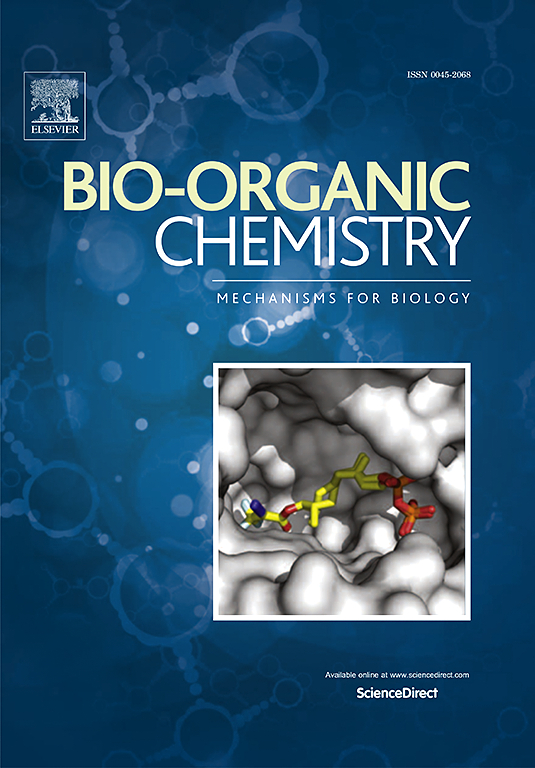Design and synthesis of thiolutin derived PSMD14/HDAC dual-target inhibitors against esophageal squamous cell carcinoma
IF 4.5
2区 医学
Q1 BIOCHEMISTRY & MOLECULAR BIOLOGY
引用次数: 0
Abstract
Esophageal cancer is one of the most migratory, invasive, and lethal malignancies and has a poor prognosis, highlighting the urgent need to develop more effective drugs for its treatment. Given that PSMD14 and HDAC play an important role in the treatment of esophageal cancer, thiolutin is used as a lead compound to design and synthesize a series of dual-target PSMD14/HDAC small molecule inhibitors, aiming to discover more effective anti-esophageal cancer drugs. Through the in vitro screening of PSMD14/HDAC enzyme inhibitory activities of a series of thiolutin derivatives, it was found that compound 8b, with a linker length of 8 and a Zn2+-chelating group of 1,2-phenylenediamine, exhibited the most balanced inhibitory activity against PSMD14/HDAC.The impact of 8b on PSMD14/HDAC at the cellular level was evaluated, and its drug-like properties were further assessed in vivo. Compound 8b demonstrates balanced dual-target activity (PSMD14 IC50 = 238.7 ± 27 nM, HDAC1 IC50 = 141.2 ± 10.3 nM) and excellent cytotoxicity against esophageal cancer cells (IC50 = 30–250 nM), effectively reversing epithelial-mesenchymal transition in cancer cells. Moreover, 8b exhibited excellent pharmacokinetic characteristics. More importantly, in a nude mouse xenograft model with subcutaneous transplantation of KYSE 30 cells, compound 8b (0.8 mg/kg, BID, PO, TGI = 81 %; 0.8 mg/kg, Q3D, SC, TGI = 77 %) significantly inhibited tumor growth, outperforming single-agent or combination treatments, thereby highlighting the therapeutic advantages of dual-target inhibition. These findings highlight the potential of dual-target PSMD14/HDAC inhibitors as a promising strategy for developing anti-esophageal cancer drugs.

硫脲类PSMD14/HDAC双靶点抑制剂的设计与合成
食管癌是最具移动性、侵袭性和致死性的恶性肿瘤之一,预后较差,迫切需要开发更有效的治疗药物。鉴于PSMD14和HDAC在食管癌的治疗中发挥着重要作用,我们以噻唑丁为先导化合物,设计合成了一系列双靶点PSMD14/HDAC小分子抑制剂,旨在发现更有效的抗食管癌药物。通过对一系列巯基黄素衍生物的PSMD14/HDAC酶抑制活性的体外筛选,发现化合物8b对PSMD14/HDAC的抑制活性最平衡,其连接体长度为8,具有1,2-苯二胺的Zn2+螯合基团。在细胞水平上评估8b对PSMD14/HDAC的影响,并进一步在体内评估其药物样性质。化合物8b具有平衡的双靶点活性(PSMD14 IC50 = 238.7±27 nM, HDAC1 IC50 = 141.2±10.3 nM),对食管癌细胞具有良好的细胞毒性(IC50 = 30-250 nM),可有效逆转癌细胞上皮-间质转化。8b具有良好的药代动力学特性。更重要的是,在KYSE 30细胞皮下移植的裸鼠异种移植模型中,化合物8b (0.8 mg/kg, BID, PO, TGI = 81%;0.8 mg/kg, Q3D, SC, TGI = 77%)显著抑制肿瘤生长,优于单药或联合治疗,从而突出了双靶点抑制的治疗优势。这些发现强调了双靶点PSMD14/HDAC抑制剂作为开发抗食管癌药物的有希望的策略的潜力。
本文章由计算机程序翻译,如有差异,请以英文原文为准。
求助全文
约1分钟内获得全文
求助全文
来源期刊

Bioorganic Chemistry
生物-生化与分子生物学
CiteScore
9.70
自引率
3.90%
发文量
679
审稿时长
31 days
期刊介绍:
Bioorganic Chemistry publishes research that addresses biological questions at the molecular level, using organic chemistry and principles of physical organic chemistry. The scope of the journal covers a range of topics at the organic chemistry-biology interface, including: enzyme catalysis, biotransformation and enzyme inhibition; nucleic acids chemistry; medicinal chemistry; natural product chemistry, natural product synthesis and natural product biosynthesis; antimicrobial agents; lipid and peptide chemistry; biophysical chemistry; biological probes; bio-orthogonal chemistry and biomimetic chemistry.
For manuscripts dealing with synthetic bioactive compounds, the Journal requires that the molecular target of the compounds described must be known, and must be demonstrated experimentally in the manuscript. For studies involving natural products, if the molecular target is unknown, some data beyond simple cell-based toxicity studies to provide insight into the mechanism of action is required. Studies supported by molecular docking are welcome, but must be supported by experimental data. The Journal does not consider manuscripts that are purely theoretical or computational in nature.
The Journal publishes regular articles, short communications and reviews. Reviews are normally invited by Editors or Editorial Board members. Authors of unsolicited reviews should first contact an Editor or Editorial Board member to determine whether the proposed article is within the scope of the Journal.
 求助内容:
求助内容: 应助结果提醒方式:
应助结果提醒方式:


